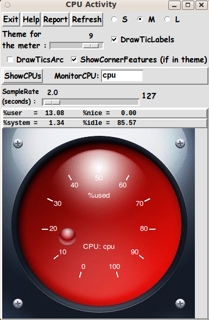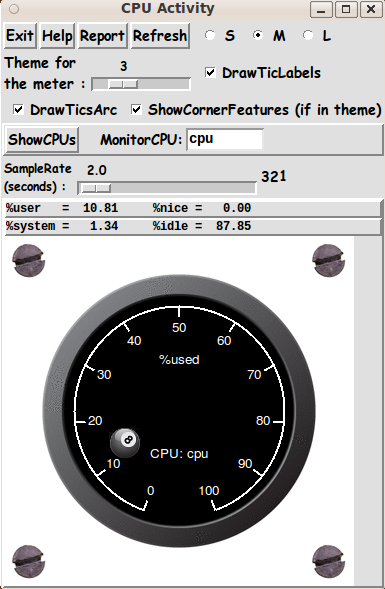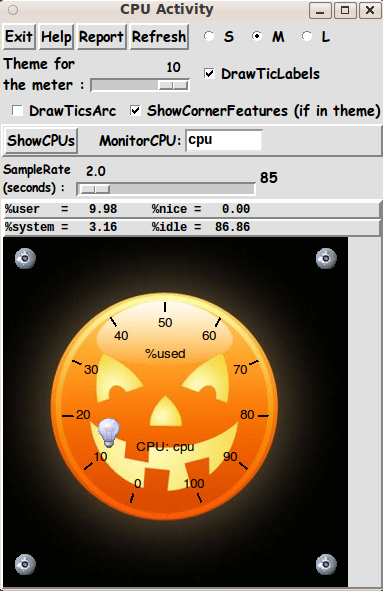|
The array 'aRimgBkgd' holds the 'prefix name' of the background
image file for the theme.
According to the setting of the S-M-L radiobuttons on the GUI,
the suffix '_SMALL' or '_MEDIUM' or '_LARGE' is added to this name.
And a file suffix of '.gif' or '.png' is added to get the complete
name of the file to be used for the meter background.
The use of '.gif' or '.png' is determined by an 'imgSUFFIX' variable,
mentioned further below, in relation to naming the 'pointer' and
'corner feature' image files.
The array 'aRticsYorN' is used to indicate whether the background image
already has tic marks on it.
If it is set to 'Y', then no tick marks (nor a circular arc) need to
be drawn by the 'make_one_meter' proc.
The factors 'aRcenterX' and 'aRcenterY' (between 0 and 1) are used to
help locate the center of the arc-circle, especially in those cases
when the background image is not symmetric --- in other words, when a
natural center point for the image is 'off-center'.
The array 'aRradiusArc' is used to adjust the radius at which the
tick marks and tick labels are drawn.
The array 'aRinORout' is used to determine whether this theme
should draw the tick marks and tick labels to the outside of
the arc-circle or the inside of the arc-circle.
The array 'aRhexcolorText' is used to set the color of the tick mark
labels and other text labels on the meter.
The array 'aRhexcolorTics' is used to set the color of the tick marks.
The array 'aRimgPointer' holds the name of the 'pointer' image file,
minus its suffix --- '.gif' or '.png'.
The array 'aRimgCornerFeature' holds the name of the 'corner feature'
image file, minus its suffix.
Generally, the person setting up theme files will want to use
transparent GIF's or transparent PNG's for these image files.
There is an 'imgSUFFIX' variable, in the 'Additional GUI Initialization'
section at the bottom of the Tk script, that can be set to 'gif' or 'png',
to determine which type of image file the user is using for the
'aRimgBkgd' and 'aRimgPointer' and 'aRimgCornerFeature' files.
The arrays 'aRstartAngle' and 'aRextentAngle' are used to specify
a start-angle and extent-angle for drawing the tic-marks arc.
The start angle is specified relative to a horizontal, right-pointing x-axis.
---
Resizing the meter
In my implementation of the Marco-Maggi-like meter,
I spent quite a bit of effort in converting Maggi's procs
So the user is able to resize the window and click on the 'Refresh' button
to get a bigger version of the meter and the needle position.
One advantage of building the entire meter with 'create line,arc,text' is
that the meter can be resized within a 'continuum' of sizes by using
some simple arithmetic.
For reasons outlined at the bottom of the
'A Tachometer-style Meter --- for CPU Usage' page,
I provide small/medium/large radiobuttons on the GUI --- by which
the user can choose 3 different image sizes, from among the images for
a user-selected theme.
SOME GUI IMAGES of implementation of the design
On the basis of these goals, I ended up with a GUI with Tk 'label', 'button',
'entry', 'radiobutton', 'checkbutton', and 'scale' widgets --- and a multitude
of theme possibilities --- as seen in the following images.

Not only can one use high-quality meter backgrounds like the one above,
but one can use abstract images like the one below.
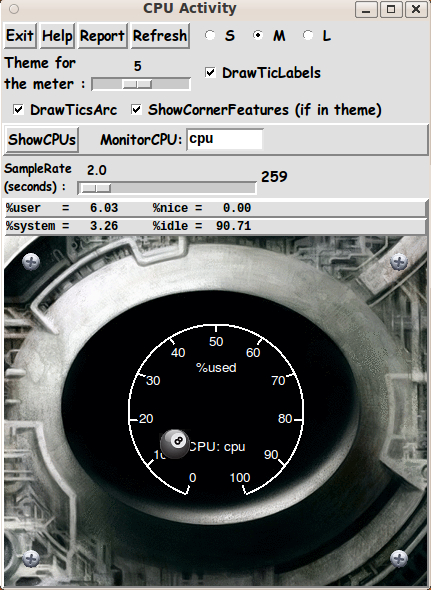
The 8-ball is the 'pointer' on this meter.
And one can take a more organic approach, like in the following image.

Almost any image with a circular solid colored background in the middle
is a good candidate for the meter background in this utility ---
as the following two images demonstrate.

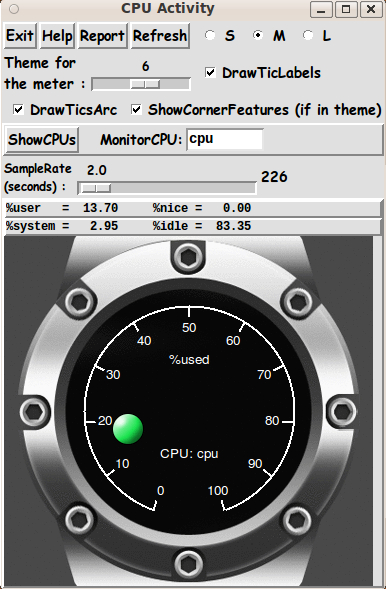
Images for Meter Backgrounds
Below are some Small-Medium-Large images for meter backgrounds.
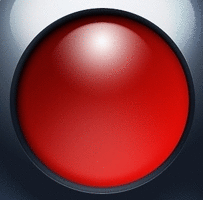
Medium
Large
Not only can one use high-quality meter backgrounds like the glossy one above,
but one can choose from other Small-Medium-Large images like the samples below.
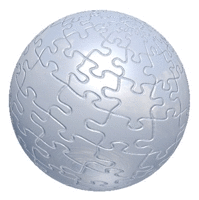
Medium
Large

Medium
Large

Medium
Large
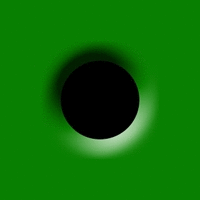
Medium
Large
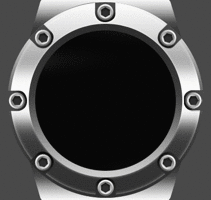
Medium
Large
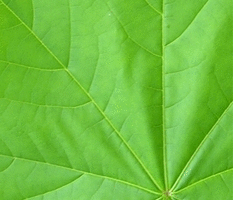
Medium
Large
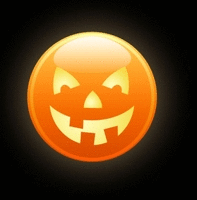
Medium
Large
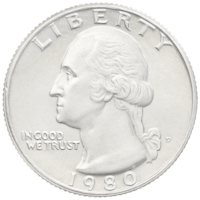
Medium
Large
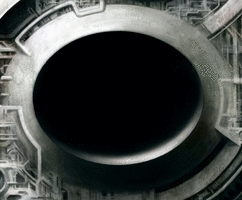
Medium
Large
'Pointer' for the meters
For this implementation, rather than try to use 'needle' pointers
and incur extra processing dealing with orienting the needle at
any of about 300 degrees or more around the meter arc, I
decided to use blunt 'bullet' pointers like the images following.
I also decided to use one size of 'pointer' for a given theme,
rather than use S/M/L sizes.










You can 'right click' on an image and choose to download
it to your computing device.
'Corner features' for the meters
For this CPU-meter implementation, rather than try to use
'corner features' (rivets, screw-heads, and the like)
of Small/Medium/Large sizes, I decided to use one size
for any theme chosen.
Below are some sample corner features.












Many of these images are rather crude. Better quality images
may be placed here in the future.
Of course, the Tk script could be rather easily changed to
accomodate S/M/L 'pointers' and 'corner_features'.
'user' and 'system' percents
As I mentioned on the 'tachometer-style-meter' page for CPU usage,
typically, there are not many 'ticks' accumulating in 'nice mode'.
So most of the 'activity' of a CPU is accumulating in the
'user' and 'system' modes.
I show the '%user' and '%system' numbers stacked above each other in a
couple of 'label' widget lines on the GUI.
Their sum will typically be the same as the %CPU value pointed to
by the 'needle'.
---
Sample count
Also as mentioned on the 'tachometer-style-meter' page,
the integer shown just to the right of the 'scale' widget is a sample-count.
I found that it is helpful to have this count displayed in cases when
the needle and numbers on the GUI are not changing perceptibly --- so
that the user is assured that the sampling is taking place, and at the
rate that is currently requested.
---
CPU ID's
The 'ShowCPUs' button on the GUI can be used to show the available
CPU-ID's.
A small window pops up showing a list of CPU-ID's.
An image on the 'tachometer-style-meter' page demonstrates that.
Also, there is an image on the 'tachometer-style-meter' page
that shows that one can change the 'MonitorCPU' entry field
so that a different CPU-ID is monitored.
In that image the CPU-ID 'cpu1' was entered --- the second of
four CPU's on my desktop computer.
On my computer, there were 5 CPU-ID's --- cpu, cpu0, cpu1, cpu2, cpu3.
The 'cpu' ID represents an average/mixture of the 4 CPU's.
---
The initial display
In making the Small, Medium, and Large images for each 'theme',
I made the 'Small' image about 200x200 pixels, the 'Medium'
about 350x350, and the 'Large' about 500x500 pixels.
When the GUI first comes up, the meter is defaulted to showing
theme number 1, the 'Small' sized image.
The CPU data shown initially is based on an initial couple of
executions of the 'cat /proc/stat' command --- from which
data for the 'cpu' CPU-ID is extracted.
---
The "Pointer"
In the Maggi-style meter, a 'needle' was drawn using 'create line'.
I had hoped to come up with a technique to avoid the 'aliasing'
effect on the needle --- but I did not devise a successful technique
for any of the 4 Maggi-tachometer-style-meter scripts that
I have done so far.
I considered trying to collect or create high-definition
needle images and try to place them on the canvas by rotating
the image at suitable angles.
However, I decided to avoid the processing in doing that.
I could try building on the rotate-image code that I used in
the Tk script presented on a page originally titled
'Rotate TkPhoto Image - via GUI with File and Bkgd-Color Select
- 2 scrollable canvases'
--- and add the code necessary to deal with transparency data
(which Tk supports) in a GIF (or PNG) image.
But I have some doubts about how successful I may be in doing
that super-efficiently.
Besides that will take a lot more development time.
I also decided to avoid the alternative of making about 320 needles,
at various angles --- for each style of needle image for the themes.
---
Another approach to making 'pointers':
(other than 'needles')
In searching for ideas for meter background images, I stumbled upon
some images of 'knobs' where the position of the rotary knob
was indicated by lighted 'spots' around the knob.
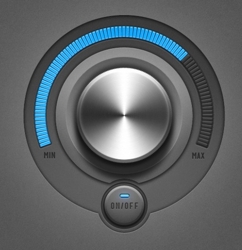
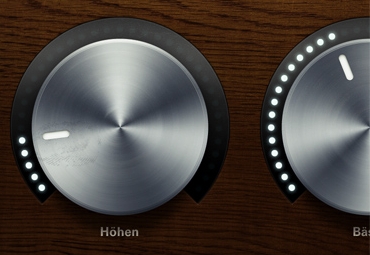
After seeing these images,
I decided that I could use images like 'bullet' icons to indicate
a position around the arc of the meter.
The Tk canvas supports transparency, so using small
transparent GIF's (or PNG's) is feasible.
So besides a background image for the meter, I have allowed for
a 'pointer' image and a 'corner feature' image (like a rivet
or screw head) to be supplied in each 'theme'.
And if a 'pointer' image is not supplied for a theme, I fall back
to using code like that used in the 'tachometer-style-meter'
Tk script --- to draw a red needle with 'create line'.
CAPTURING THE GENERATED IMAGE:
When you get an image that you want to save,
a screen/window capture utility (like 'gnome-screenshot' on Linux)
can be used to capture the GUI image in a PNG or GIF file, say.
If necessary, an image editor (like
'mtpaint' on Linux) can be used to crop the window capture image.
(The image could also be down-sized with the editor --- say, to make a
smaller image suitable for presentation in an email or on a web page.)
This is the technique that I used to prepare the images that
I posted above, to show some GUI features of this utility.
However, I replaced the relatively large PNG files that came from
the 'mtpaint' editing step with smaller 'crushed' files that
were created by the 'pngcrush' command.
DESCRIPTION OF THE CODE
Below, I provide the Tk script code for this 'high-definition CPU-usage'
display utility.
I follow my usual 'canonical' structure for Tk code for this Tk script:
|
